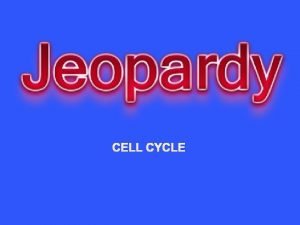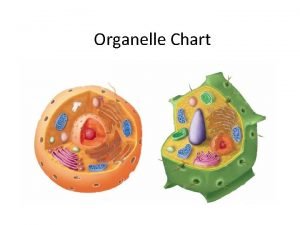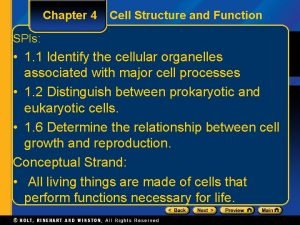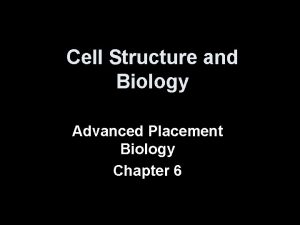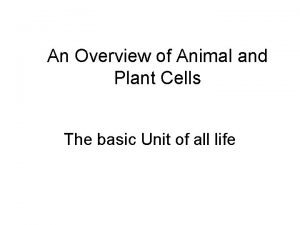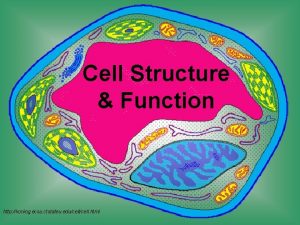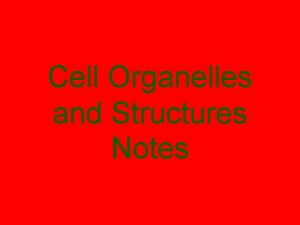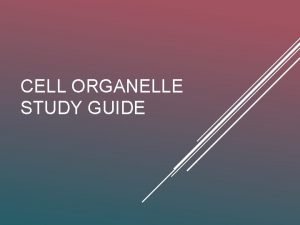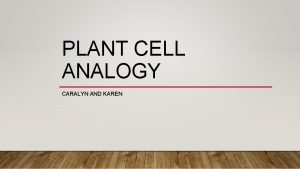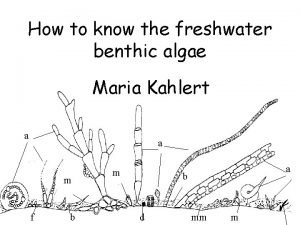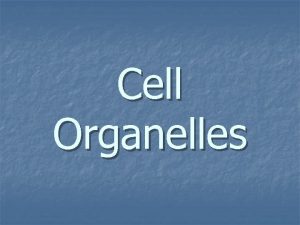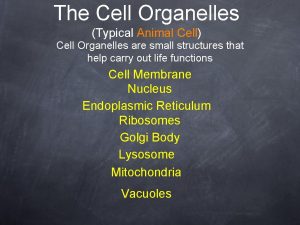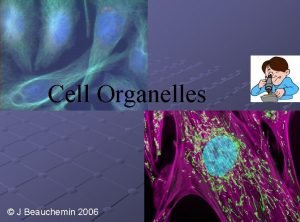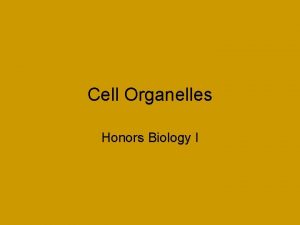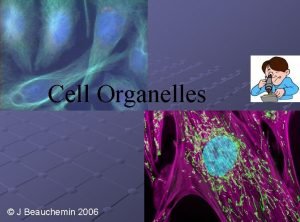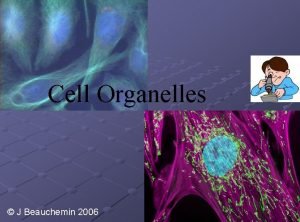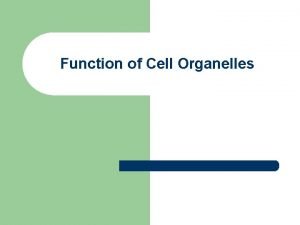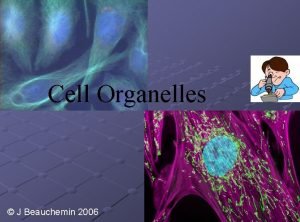CELL ORGANELLES 8 th Grade Science ORGANELLES AND














- Slides: 14

CELL ORGANELLES 8 th Grade Science

ORGANELLES AND THEIR FUNCTIONS In this activity you will look at the eukaryotic cells of plants and animals. Eukaryotic cells are distinguished from the more primitive prokaryotic cells by the presence of 1) cytoplasmic membranous organelles, 2) a nuclear membrane (i. e. a true nucleus), and 3) chromosomal proteins. In this lab we will focus primarily on organelles, their functions within the cell and how they differ between plant and animal cells.

MICROSCOPIC CITY Think of the cell as a microscopic city. Like a real city it requires many services to keep it clean and running smoothly. Think of some of the services a real city needs: traffic control, waste disposal, and authority figure just to name a few. Like our imagined city a cell needs the same services. Organelles are the “workers” that provide these services. The following is a list describing the various functions of some common organelles.

NUCLEUS (“MAYOR OF CITY HALL”) The nucleus houses the majority of genetic material of a cell. The nucleus is the “brain” of the cell and controls all activity within the cell. Using DNA as a blueprint (like the blueprints of a city) the nucleus directs the production of proteins. You will learn about this process in the DNA Transcription and Translation lab. A nucleus with the DNA coiled into chromatin Electron microscope view of nucleus

RIBOSOMES (“LUMBER OR BRICK YARD”) The ribosomes carry out manual labor in the form of protein synthesis for the nucleus. They bring together all the raw ingredients such as RNA (copies of the original DNA blueprints) and amino acids to assemble proteins. The proteins created are essential to cell and organismal function. Think of proteins as machinery for cell functions much like electricity and plumbing are essential in a real city. For example, enzymes are a type of protein without which life could not exist.

THE ENDOPLASMIC RETICULUM (“HIGHWAYS AND ROAD SYSTEMS”) There are two types of endoplasmic reticulum (ER) – Smooth ER and Rough ER. This extensive network makes up approximately one half of all membranous tissue of the cell and is the site of membrane and protein synthesis. The ER system is much like a road system along which industry can be found. Goods are manufactured and shipped to needed areas via the road system. Rough ER is named for the presence of ribosomes along its membrane and is the source of proteins. Smooth ER lacks ribosomes and is responsible for lipid synthesis and processes a variety of metabolic processes such as drug detoxification. Can you tell the difference between the rough and smooth ER?

CELL MEMBRANE (“CITY BORDER”) AND CELL WALL (“CITY WALL”) Cell membranes are found in animal cells whereas cell walls are found in plant cells. Cell walls and membranes have similar functions. Like a city perimeter, cell membranes surround the cell and have the ability to regulate entrance and exit of substances, thereby maintaining internal balance. These membranes also protect the inner cell from outside forces. Cell walls, as the city analogy implies, are much stronger than cell membranes and protect cells from lysing (exploding) in extremely hypotonic (diluted) solutions. You will learn more about these concepts in the Biological Membranes lab.

CYTOSKELETON (“STEEL GIRDERS”) The cytoskeleton makes up the internal framework, like the steel girders that are the framework for buildings in a city that gives each cell its distinctive shape and high level of organization. It is important for cell movement and cell division (mitosis).

CYTOPLASM (“LAWNS AND PARKS”) Cytoplasm is a semi-fluid substance (think gelatin) found inside the cell. The cytoplasm encases, cushions and protects the internal organelles. It is the cell landscape found in any space where organelles are not and therefore is much like the lawns and parks of our city.

GOLGI APPARATUS (“POST OFFICE”) Like a post office, the golgi apparatus is used for shipping those goods created by the ER and ribosomes to the rest of cell.

CHLOROPLASTS (“SOLAR ENERGY PLANT”) Chloroplasts are organelles found only in plant cells. Like a solar energy plant they use sunlight to create energy for the city. Chloroplasts are the site of photosynthesis a process in which the plant uses carbon dioxide, water and sunlight to create energy in the form of glucose for the plant cell as well as heterotrophs that consume the plant

MITOCHONDRIA (“ENERGY PLANT”) Mitochondria are found in both plant and animal cells and is the site of cellular respiration. Through this process that will be covered in the Photosynthesis and Respiration lab ATP is created which is used for energy by the cell.

LYSOSOMES (“WASTE DISPOSAL AND RECYCLING”) The lysosomes are digestive sacs that can break down macromolecules in the cell using the process of hydrolysis. The digestion is carried out with lysosomal enzymes found in the lysosome. Like waste disposal in a city, lysosomes help keep excessive or bulky macromolecules from building up in the cell.

VACUOLES AND VESICLES (“WAREHOUSES, WATER TOWERS OR GARBAGE DUMPS”) Think of these membrane sacs that have a variety of functions as containment units for anything in excess in a city. They can hold many substances from organic molecules to simple excess water. Plant cells have a central vacuole that is important in maintaining plant turgidity. You can read more about this phenomenon in the Biological Membranes Lab. Copyright http: //biology. unm. edu/ccouncil/Biology_124/Summaries/Cell. html
 During interphase a cell grows duplicate organelles and
During interphase a cell grows duplicate organelles and Functionlocation
Functionlocation Which of the following pairs contains unrelated items?
Which of the following pairs contains unrelated items? Cell structure graphic organizer
Cell structure graphic organizer Organelle
Organelle Label the organelles in the composite cell
Label the organelles in the composite cell Label the organelles in the composite cell
Label the organelles in the composite cell Cell organelles song
Cell organelles song Nucleoid region
Nucleoid region Golgi bodies nickname
Golgi bodies nickname Wall and studs organelle
Wall and studs organelle Organelle functions chart
Organelle functions chart Vacuole analogy
Vacuole analogy Aamfb
Aamfb What is this cell
What is this cell
